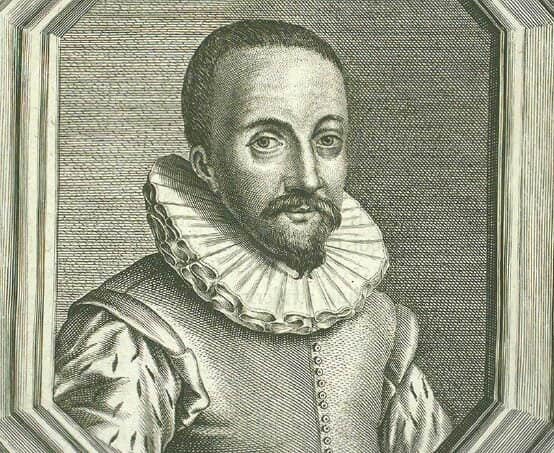Hans Lipperschlei of Holland is often credited with inventing the first telescope, but it is likely that he was not the true discoverer. Instead, he is recognized for popularizing and making the telescope instrument widely sought after. In 1608, he applied for a patent for a pair of lenses housed in a tube, which he called a telescope tube. However, his patent was rejected due to the perceived simplicity of his device.
Prior to Lipperschlei, astronomer Thomas Digges attempted to magnify stars in 1450 using a convex lens and a concave mirror. However, he did not have the patience to refine the device, and his semi-invention was soon forgotten. Digges is now primarily remembered for his description of the heliocentric system.
By the conclusion of 1609, thanks to Lippershley, the utilization of small telescopes had become widespread in France and Italy. Thomas Harriot further developed and enhanced the invention in August 1609, enabling astronomers to observe craters and mountains on the lunar surface.
Galileo Galilei and his encounter with the telescope

The major breakthrough occurred when Galileo Galilei, an Italian mathematician, learned about a Dutchman’s attempt to patent a lenticular tube. Inspired by this discovery, Galileo Galilei decided to create his own version of the device. In August 1609, Galileo became the inventor of the world’s first fully functional telescope. Initially, it was a simple telescope, combining spectacle lenses, which today would be referred to as a refractor. Prior to Galileo, it is unlikely that many individuals had the foresight to utilize this recreational tube for the advancement of astronomy. Thanks to this instrument, Galileo himself made numerous valuable discoveries, including the identification of mountains and craters on the moon, the confirmation of its spherical shape, the discovery of Jupiter’s four satellites, Saturn’s rings, and many other significant findings.
The observation of stars in the 17th century
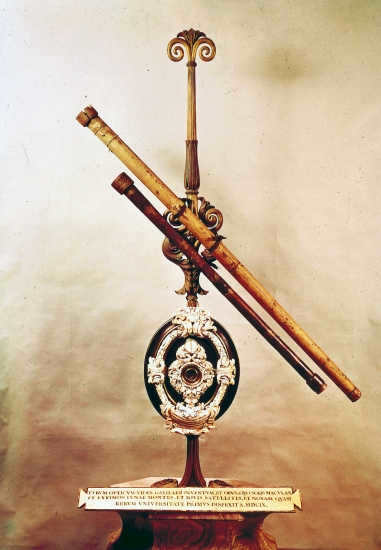
Over time and with advancements in science, the development of telescopes progressed, resulting in the creation of more powerful devices that offered enhanced visibility. Astronomers began utilizing lenses with longer focal lengths, which led to the enlargement of the telescopes themselves. These telescopes became large and cumbersome, making them inconvenient to use. To address this issue, tripods were invented to provide stability. The telescopes underwent gradual improvements and refinements. However, due to the limitations of lens production, the maximum diameter of the lenses did not exceed a few centimeters.
Christian Huyens achieved a significant milestone in 1656 by creating a telescope that had a magnification power of 100x and was over 7 meters in size, with an aperture of approximately 150 mm. This groundbreaking invention is now comparable to modern beginner-level amateur telescopes. In the 1670s, another remarkable achievement was made with the construction of a 45-meter telescope, which not only increased the magnification of observed objects but also provided a wider field of view.
Isaac Newton and his contribution to the development of the reflector
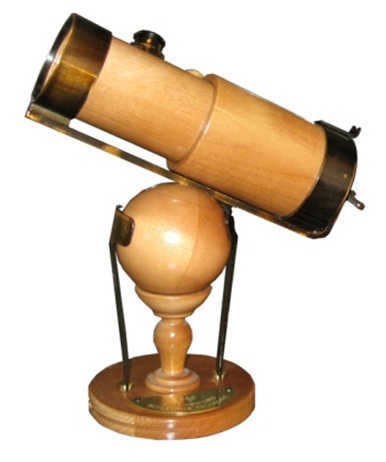
However, even ordinary wind could pose a challenge in obtaining a clear and high-quality image. The telescope began to undergo elongation. The discoverers, in their quest to optimize this device, relied on a discovered optical principle – the reduction of chromatic aberration in a lens as its focal length increases. To eliminate chromatic interference, the researchers constructed telescopes of extraordinary length. These elongated tubes, known as telescopes at the time, extended up to 70 meters and presented numerous inconveniences in their operation and adjustment. The drawbacks of refractors prompted brilliant minds to seek solutions for enhancing telescopes. The solution and a new approach were discovered: the gathering and focusing of rays was accomplished with the aid of a concave mirror. The refractor was reborn as a reflector, completely devoid of chromatism.
The credit for this achievement belongs solely to Isaac Newton, who revolutionized the use of mirrors in telescopes. Newton’s initial reflector was a mere four centimeters in diameter. In 1704, he created the first mirror for a telescope with a 30mm diameter, using a copper, tin, and arsenic alloy. This innovation resulted in a clear image. Interestingly, Newton’s first telescope is still carefully preserved in the Astronomical Museum in London.
However, it took a while for opticians to produce fully functional mirrors for reflectors. The birth of a new type of telescope is often attributed to the year 1720, when the British constructed the first operational reflector with a 15-centimeter diameter. This was a significant breakthrough. In Europe, there was a growing demand for portable, compact telescopes that were around two meters in length. The previously popular 40-meter long refractor tubes started to fade into obscurity.
If it hadn’t been for the discovery of English opticians, the 18th century could have been known as the century of the refractor. These opticians found the perfect combination of two lenses made from crown and flint.
By the end of the 18th century, large reflectors had been replaced by compact and convenient telescopes. Metal mirrors were not practical either, as they were expensive to produce and would tarnish over time. However, in 1758, two new types of glass were invented: lightweight crown and heavy flint. This breakthrough allowed for the creation of two-lens lenses. Scientist J. Dollond took advantage of this discovery and created a two-lens lens, which later became known as the Dollond lens.
The Herschel and Ross telescopes
The telescopes known as Herschel and Ross are both impressive pieces of technology. These telescopes have made significant contributions to the field of astronomy. The Herschel telescope, named after the famous astronomer William Herschel, was launched into space in 2009. It is the largest infrared telescope ever flown in space and has provided astronomers with valuable data about star formation and galaxy evolution. The Ross telescope, on the other hand, is a radio telescope located in California. It is named after its founder, Bernard Ross, and has been instrumental in studying radio waves emitted by celestial objects. Both telescopes have greatly expanded our understanding of the universe and continue to be important tools for astronomical research.
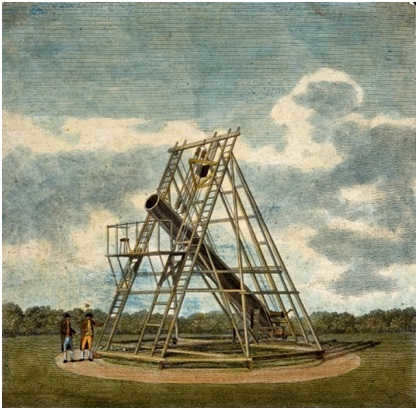
This significant achievement was achieved with the active involvement of Russian scientists. J.V. Bruce gained recognition for his groundbreaking work in developing specialized metal mirrors for telescopes. Independently, Lomonosov and Herschel revolutionized telescope design by creating a new configuration that eliminated the need for a secondary mirror, resulting in reduced light loss.
German optician Fraunhofer played a crucial role in streamlining the production and improving the quality of lenses. In fact, even today, the Tartu Observatory possesses a fully functional telescope equipped with an original Fraunhofer lens. However, it’s important to note that Fraunhofer’s refractors were not without their own drawback – chromatic aberration.
The peak of refractive astronomy
The Frenchman Cassegrain proposed the two-mirror system for the telescope. However, at that time, he couldn’t fully realize his idea due to the lack of technological capability to create the necessary mirrors. Today, his designs have been brought to life. The Newton and Cassegrain telescopes, which were invented in the late 19th century, are considered the first “modern” telescopes. Interestingly, the Hubble Space Telescope operates on the same principle as the Cassegrain telescope. On the other hand, the Special Astrophysical Observatory in Russia has been using Newton’s fundamental principle, which involves a single concave mirror, since 1974. Refractor astronomy reached its peak in the 19th century, with the diameter of achromatic lenses gradually increasing. In 1824, the diameter was only 24 centimeters, but by 1866, it had doubled in size. The Pulkovo Observatory in Russia had a diameter of 76 centimeters in 1885, and the Yerkes refractor was invented by 1897. This means that the size of the lens increased by one centimeter per year over a span of 75 years.
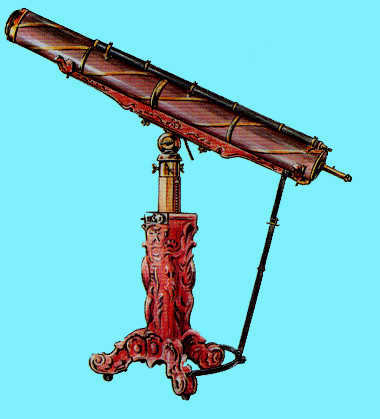
The past events in the development of telescopes
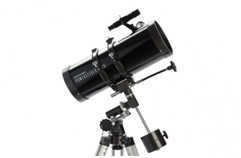
In 1976, scientists in the Soviet Union constructed the Bolshoi Telescope Azimutalny (BTA), a 6-meter telescope that was considered the largest in the world until the end of the 20th century. The creators of the BTA were pioneers in implementing innovative technical solutions, such as a computerized alt-azimuth system for guidance. Nowadays, this groundbreaking technology is utilized in nearly all of the enormous telescopes. As the 21st century began, the BTA slipped into the ranks of the second ten largest telescopes globally. Over time, the mirror of the BTA has gradually deteriorated, losing 30% of its original quality, rendering it solely a historical monument to scientific progress.
The next generation of telescopes includes two massive 10-meter twin telescopes, KECK I and KECK II, designed for optical infrared observations. These groundbreaking telescopes were erected in the United States in 1994 and 1996, thanks to the support of the W. Keck Foundation, which generously contributed over $140,000 towards their construction. Remarkably, despite their colossal size – comparable to that of an eight-story building – each telescope weighs over 300 tons, yet operates with unparalleled precision.
The key feature of these telescopes is their 10-meter diameter main mirror, composed of 36 hexagonal segments that function as a single reflective surface. Positioned on the slope of the 4,200-meter-high dormant volcano, Manua Kea, in Hawaii, these telescopes benefit from one of the most optimal locations on Earth for astronomical observations. It is in this extraordinary setting that the telescopes were installed.
By 2002, the two telescopes, situated 85 meters apart, began operating in interferometer mode, effectively providing the same angular resolution as that of an 85-meter telescope.
And in June 2019, NASA is scheduled to send the extraordinary James Webb Infrared Telescope (JWST) with a 6.5-meter mirror into space.
The evolution of the telescope has been a remarkable journey, from the skilled craftsmen of Italy to the cutting-edge satellite telescopes we have today. Modern observatories have embraced computerization, but the foundations of their operation, like those of amateur telescopes and instruments such as Hubble, still trace back to the innovative principles discovered by Galileo.
Irina Kalina, 15.04.2014.
Update: Tatiana Sidorova, 02.11.2018
Reprinting without an active link is strictly prohibited!
This article provides a concise and informative overview of the astronomy course offered at universities. One notable advantage is the inclusion of numerous problem sets with corresponding examples and solutions.
The author extends an invitation to embark on yet another extraordinary journey into the depths of the universe, offering a fresh perspective on the reality that surrounds us.
Be sure to check out our other articles on telescopes:
Galileo’s Telescope (1609)
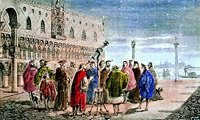

Although the telescope had been invented by someone else, Galileo Galilei made significant improvements to it, greatly enhancing its capabilities. Furthermore, Galileo Galilei was the first to realize that the telescope could be utilized not only for observing distant objects on Earth but also for studying the heavens.
The image depicts Galileo demonstrating one of his telescopes to the rulers of Venice in August 1609. In the subsequent years, Galileo made numerous crucial observations, including the identification of four major satellites of Jupiter.
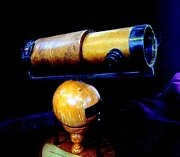
Instead of using glass lenses to refract light rays, Isaak Newton opted for curved mirrors. These mirrors have the ability to both collect and scatter light, depending on their shape. Unlike lenses, mirror-based designs allow for a much greater magnification of objects. Additionally, the use of mirrors solves the problem of chromatic aberration, a phenomenon that causes different parts of the spectrum to refract differently, resulting in image distortion.
However, Newton’s first reflecting telescope suffered from a poor quality mirror, resulting in significant image distortion and darkening. It wasn’t until over a century later that reflecting telescopes gained popularity among astronomers, as mirrors with better polishing and light absorption capabilities became available.
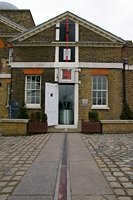

Observatory in Greenwich
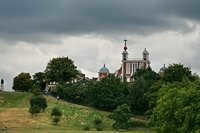
Since 1675, the Royal Greenwich Observatory has served as the primary astronomical institution in the United Kingdom. Initially established by King Charles II to support navigation and related research, the observatory was situated in Greenwich, a suburb of London. Due to England’s prominence as a maritime power during that era, there was a pressing need for highly accurate instruments for ship positioning, cartography, and navigation at sea. The meridian that runs through Greenwich holds significance in Great Britain and its colonies, serving as the zero point for longitude calculations. This meridian has also been adopted worldwide since 1884 as the standard reference for determining time zones.
At this location, the Greenwich Observatory, back in 1676, John Flamsteed, the initial astronomer appointed by the royal family, commenced his observations of celestial bodies such as stars and the Moon. By the conclusion of the 19th century, the Greenwich Observatory boasted an impressive array of astronomical instruments, including a 76cm reflector, as well as refractors measuring 71cm, 66cm, and 33cm in size. Additionally, numerous auxiliary instruments were also in use. However, in 1953, a portion of the observatory was relocated approximately 70km to the southwest, to the historic Hurstmonso Castle, dating back to the late medieval period.
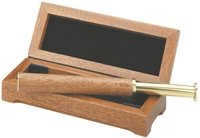
The renowned Russian scientist M.V. Lomonosov not only conceived and constructed over a dozen innovative optical devices, but also established the Russian tradition of scientific and practical optics. Among his notable inventions was a groundbreaking night-vision telescope, aptly named by Lomonosov himself, as well as a novel form of reflecting telescope that would go on to be employed by Herschel in his iconic instrument.
Herschel’s optical instruments
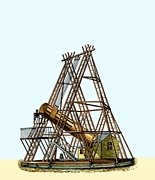
John Frederick William Herschel constructed his initial telescope in 1774, taking inspiration from Lomonosov’s concepts and calculations (according to other accounts, Herschel and Lomonosov separately devised optical systems with similar operational principles). Herschel continuously enhanced the telescope’s design, ultimately creating a 20-foot (6m) telescope. The instrument was quite cumbersome, necessitating a team of four individuals to maintain it. For numerous decades, it held the distinction of being the largest telescope globally.
Herschel created an extensive collection of stars and nebulae, conducted valuable studies on the planets within our solar system. In 1781, he was able to confirm that Uranus was indeed a planet, not a star, and additionally discovered two satellites of Uranus and two satellites of Saturn. Herschel’s son also followed in his father’s footsteps, dedicating his time to celestial optics. He even spent a number of years in South Africa constructing a telescope similar to his father’s in order to explore the southern hemisphere’s skies.
Pulkovo Observatory
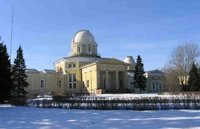 The Pulkovo Observatory, also known as the Main (Pulkovo) Astronomical Observatory of the Russian Academy of Sciences (GAO RAS), is currently the primary astronomical observatory operated by the Russian Academy of Sciences.
The Pulkovo Observatory, also known as the Main (Pulkovo) Astronomical Observatory of the Russian Academy of Sciences (GAO RAS), is currently the primary astronomical observatory operated by the Russian Academy of Sciences. 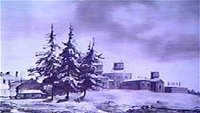 Situated on the Pulkovo Heights, it is located approximately 19 kilometers south of St. Petersburg.
Situated on the Pulkovo Heights, it is located approximately 19 kilometers south of St. Petersburg.

Up to this point, the observatory’s scientific endeavors encompass a wide range of crucial fields within contemporary astronomy: celestial mechanics and stellar dynamics, astrometry (which focuses on the geometric and kinematic properties of the Universe), the study of the Sun and its relationship with Earth, the physics and evolution of stars, and the development of equipment and techniques for astronomical observations.
Crimean Astronomical Institute

The Crimean Astrophysical Observatory was established in the early 20th century near the village of Simeiz on Mount Koshka as a private observatory belonging to Nikolay Maltsov, an amateur astronomer. In 1912, it was gifted to the Pulkovo Observatory, leading to its transformation into a fully-fledged scientific institution that conducted photometry of stars and minor planets. In 1926, the Crimean Observatory installed a meter-long English reflector, which was one of the largest refractors of its time. During World War II, both the Crimean and Pulkovo Observatories suffered severe damage, but were later reconstructed and improved.
The Hale 200-inch telescope, which was built in 1948, is a unique piece of equipment.
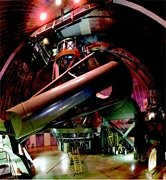

George Ellery Hale, an avid astronomer, constructed a 60″ telescope on Mount Wilson, located northeast of Los Angeles, in 1908. In 1917, the 100″ Wilson Telescope was installed at that location, and it held the title of the world’s largest telescope for three decades. However, Hale was not content with the 100″ telescope and desired to create a telescope twice its size. In 1928, Hale began advocating for the construction of a 200″ telescope. He successfully obtained financial backing from Chicago millionaire Charles Yerkes, and the 200″ (5.1m) Hale Telescope was built on Mount Palomar, situated south of Los Angeles. It was finished in 1948, ten years after Hale’s passing. This telescope held the distinction of being the world’s largest for a decade.
The Hale telescope is equipped with enormous mirrors crafted from a revolutionary glass known as Pyrex, designed to remain unaffected by temperature fluctuations, preserving its shape and size. Positioned at the base of the telescope, the mirror efficiently reflects starlight, while the observer’s cabin is situated at the top. Moreover, an extra mirror has the capability to redirect light through a central aperture in the primary mirror.
Hubble Space Telescope (Hubble, 1990)
The Hubble Space Telescope, also known as Hubble, was launched into space in 1990.
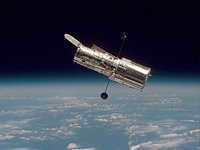
Named after the renowned astronomer Edwin Powell Hubble, the Hubble telescope draws its inspiration from the scientist’s significant contributions to understanding the vastness of our universe. Hubble formulated the law that states, “galaxies move away from each other at a speed that is directly proportional to the distance between them.” It is worth noting that a considerable number of Hubble’s observations were conducted with the aid of Hale telescopes.
The launch of the Hubble Telescope in April 1990 marked a significant milestone in the field of astronomy. It was the first time a telescope had been positioned outside Earth’s atmosphere, eliminating distortions caused by the atmosphere’s interference with light transmission. The Hubble Telescope enabled scientists to more accurately measure the rate of the universe’s expansion, uncover numerous new stars and nebulae, and even confirm the existence of dark matter, previously only theorized by physicists. Notably, the Hubble Telescope also became the first man-made object in space to undergo maintenance and repairs directly in space. Its fifth and most recent repair occurred on May 11, 2009, with plans for a potential future repair in 2014.
WMAP (Wilkinson Microwave Anisotropy Probe, 2001) is a space mission that was launched in 2001.
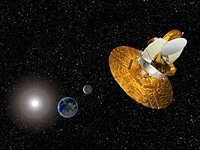
The WMAP spacecraft, developed by NASA, was specifically designed to study the residual radiation generated by the Big Bang. While not technically classified as a telescope, WMAP served as a research satellite. Its main accomplishments include producing the first comprehensive map of the microwave range in the sky, determining the age of the Universe (13.7 billion years), and measuring the composition of the Universe within its immediate vicinity. The findings revealed that approximately 72% of the Universe is composed of dark energy, 23% is dark matter, and only 5% is ordinary matter.
On May 14, 2009, the Planck satellite (Planck) was launched as the successor to WMAP. The Planck instruments boast a theoretical sensitivity that is 10 times higher and an angular resolution that is 3 times higher than those of WMAP.
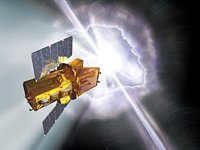
The purpose of the Swift orbiting X-ray telescope is to investigate rapid cosmic events known as gamma-ray bursts, which are believed to occur when a massive star perishes or when two dense objects like neutron stars merge. Prior to its launch in 2004, it took astronomers approximately 6 hours to gather all the necessary data after detecting a gamma-ray burst. However, with Swift, it takes no more than a minute to start recording all the gamma-ray flux data after the burst is detected. Swift has already captured hundreds of gamma-ray bursts, and in April 2009, it detected a gamma-ray burst from the farthest cosmic object ever documented.
Acknowledgements: We would like to express our gratitude to the resources of NewScientist, Astronomer.ru, and Wikipedia for providing the information used in this text.
The Invention of the Telescope
A telescope, derived from the ancient Greek word for “looking into the distance,” is an apparatus utilized to observe distant objects by gathering electromagnetic radiation, such as visible light.
Various types of telescopes cater to different ranges of the electromagnetic spectrum, including:
- Optical telescopes
- Radio telescopes
- X-ray telescopes
- Gamma-ray telescopes
Neutrino detectors are also commonly referred to as telescopes and are sometimes known as gravitational wave detectors as well.
Democritus, in 385 B.C., originally proposed that the Milky Way is composed of numerous stars. Some experts argue that this theory is only possible due to telescopic observations, while others point to surviving Greek and Roman texts that describe an optical device similar to the modern telescope.
The initial efforts to invent the telescope
The earliest designs for a basic telescope lens were discovered in Leonardo da Vinci’s writings in 1509. His note, “Create spectacles for observing the full moon” (“The Atlantic Codex”), has been preserved.
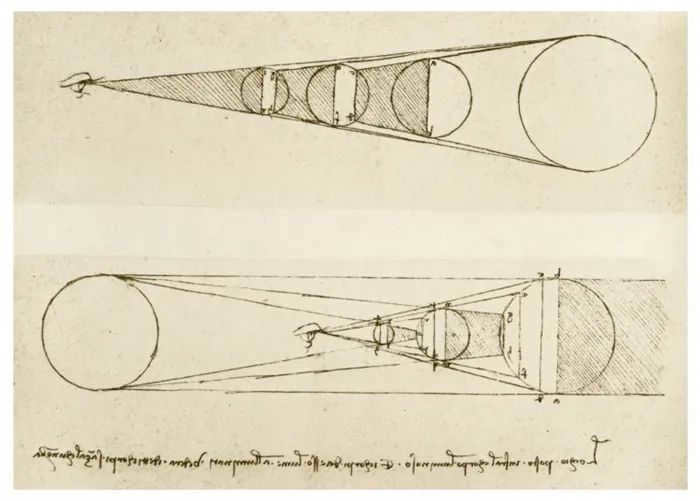
Illustrations showcasing the telescope crafted by Leonardo da Vinci
In more recent times, the credit for inventing the first-ever telescope has been given to Hans Lipperschlei from the Netherlands. However, not many are aware that Thomas Digges, an astronomer, had attempted to amplify the stars using a convex lens and a concave mirror as early as 1450.
Unfortunately, Digges lacked the perseverance to perfect his creation, and his semi-invention was soon forgotten. Today, Digge’s contribution to the heliocentric system is recognized, and it is likely that Lipperschley deserves recognition for popularizing and meeting the demand for the new telescope device. It was Lipperschley who, in 1608, filed a patent for a pair of lenses mounted on a tube, which he called a telescope. However, his patent was rejected as his device appeared too simplistic.
By the close of 1609, the use of small telescopes had become prevalent in France and Italy, all thanks to Lipperschlei. In August of the same year, Thomas Harriot made significant improvements to the invention, enabling astronomers to observe the moon’s craters and mountains.
Galileo Galilei and his association with the telescope
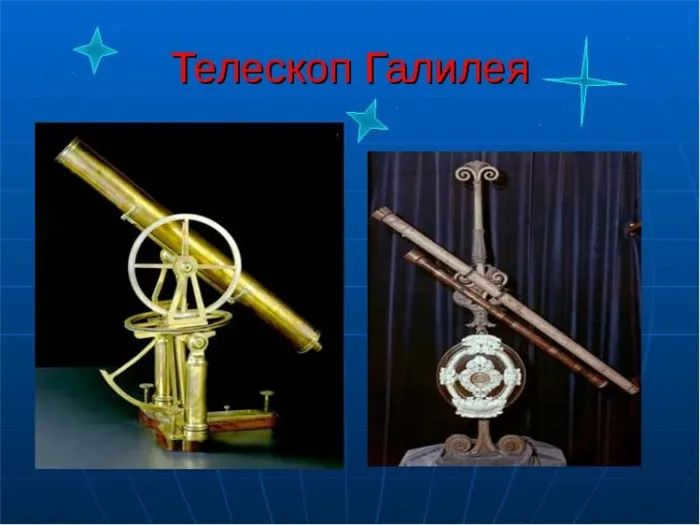
The major breakthrough occurred when Galileo Galilei, an Italian mathematician, learned about the attempts of a Dutchman to patent a refracting telescope. Inspired by this revelation, Galileo Galilei decided to construct a similar device himself. In August 1609, Galileo became the creator of the world’s first fully functioning telescope.
Initially, it was simply a telescope, a combination of glass lenses that we would now refer to as a refractor. Prior to Galileo’s advancements, few individuals could fathom the potential of this peculiar-looking tube for the field of astronomy.
Thanks to this instrument, Galileo himself was able to make significant discoveries, such as identifying mountains and craters on the moon, proving the moon’s spherical shape, discovering the four moons of Jupiter, the rings of Saturn, and numerous other valuable findings.
In the late 19th century, Crossley, an amateur astronomer, opted for aluminum mirrors and promptly installed a 91 cm diameter concave glass parabolic mirror in his telescope.
Hans Lippersgei
Many people mistakenly attribute the invention of the telescope to Galileo, as he was the first to use it for observing the night sky. However, the telescope, or rather the concept of a telescope, was actually first demonstrated in 1608 by Hans Lippersguy, a Dutch showman from The Hague. Unfortunately, he did not receive a patent for his invention, as other craftsmen like Zacharias Jansen of Middelburg and Jacob Metius of Alkmaar had already developed similar telescopes.
Hans utilized a pair of glass lenses within a tube to enhance the size of faraway objects in his telescope. Without a doubt, he stands out as the main figure among the inventors of this device. However, Lippersgay may not have been the originator of the idea. There were at least two other Dutch opticians who were also developing the same concept simultaneously. Nevertheless, Lippersgay is acknowledged as the inventor of the telescope since he was the first one to file a patent for it.
Galileo Galilei
In 1609, Galileo Galilei became aware of the invention and decided to construct his own telescope, which had a magnification of three times. He then went on to improve his design, creating a telescope that was approximately half a meter in length and had eight times magnification. Galileo’s ingenuity didn’t stop there, as he later developed a telescope that allowed for a magnification of 32 times, a groundbreaking achievement at the time.
The final version of Galileo’s telescope measured around a meter in length, with a lens diameter of 4.5 cm. While the instrument had various imperfections and misalignments, it was still a remarkable accomplishment for its era. With the aid of this telescope, Galileo made several noteworthy discoveries, including the observation of Venus’ phases, the identification of the mountains and craters on the Moon, the revelation of Jupiter’s moons, the detection of sunspots, and the examination of stars within the Milky Way.
By the way, the Greek mathematician Giovanni Demissiani suggested the name “telescope” for one of Galileo’s instruments in 1611. Galileo himself used it for his telescopes. The term “perspicillum” (spectacles) was also used.
Leonard Digges
Interestingly, many believe that the famous 16th-century mathematician and surveyor Leonard Digges was the first inventor of the telescope. His son Thomas Digges published most of his work. In Thomas Digges’ 1570 notes, he describes how Leonard Digges used “analog glass” to observe distant objects. Some scholars, like astronomer and historian Colin Ronan, argue that it had reflecting or refracting capabilities. It was constructed between 1540 and 1559, but its vague description and claimed characteristics raise doubts about this.
So, the story goes that Galileo is often credited with being the first person to invent the telescope. However, it was actually his significant contributions to improving and utilizing this technology for observing celestial bodies that popularized it in Europe. Nevertheless, historians of astronomy are still uncertain about the true originator of the telescope, with many pointing to the Dutch spectacle-maker, Hans Lippersgai, as a strong contender.
Author: Fedor Karasenko. Editor: Fedor Karasenko.
If you enjoyed this article, please give it a thumbs up to see more space and science content in your feed!
Don’t forget to subscribe to my channel on YouTube and follow my Telegram channel. I share a wealth of interesting material and am available to answer any questions you may have. If you’d like to support our channel financially, you can do so through Patreon.
Greenwich Observatory
The Greenwich Observatory is a renowned institution that has played a significant role in the study of astronomy and the measurement of time. Located in Greenwich, London, it is a historic site that has been at the forefront of scientific research for centuries.
One of the main attractions of the observatory is the Prime Meridian Line, which marks the division between the Eastern and Western hemispheres of the Earth. This line has served as the reference point for measuring longitude since it was established in the late 19th century.
In addition to its historical significance, the Greenwich Observatory is also home to a variety of astronomical instruments and telescopes. Visitors can explore the grounds and learn about the history of astronomy, as well as observe the night sky through the observatory’s telescopes.
The observatory also offers educational programs and workshops for students and aspiring astronomers. These programs provide hands-on learning experiences and help foster a deeper understanding of the universe and our place in it.
Overall, the Greenwich Observatory is a must-visit destination for anyone interested in astronomy and the history of scientific discovery. Its rich history and ongoing research make it a fascinating place to explore and learn about the wonders of the universe.
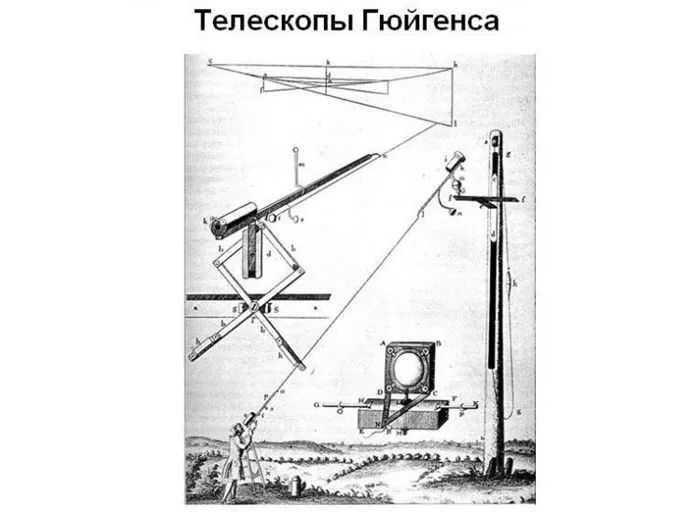
Established in 1675 by King Charles II, the Royal Observatory at Greenwich has played a vital role in astronomical research in Britain. Situated in the suburb of London, Greenwich, the observatory was primarily established for navigational and other related purposes. During that period, England was a dominant maritime power and required highly accurate instruments for activities like ship positioning, sea navigation, and cartography. The meridian that runs through Greenwich was chosen as the zero point for Great Britain and its colonies. Since 1884, it has been used to calculate time zones around the world.
In 1676, John Flamsteed, the first royal astronomer, started observing the stars and the moon at the Greenwich Observatory. By the late nineteenth century, the observatory had various instruments including a 76-cm reflector and refractors of 71 cm, 66 cm, and 33 cm. In 1953, a portion of the observatory was relocated to Herstmonso Castle, a medieval castle located 70 km southwest.
Telescopes designed by Lomonosov
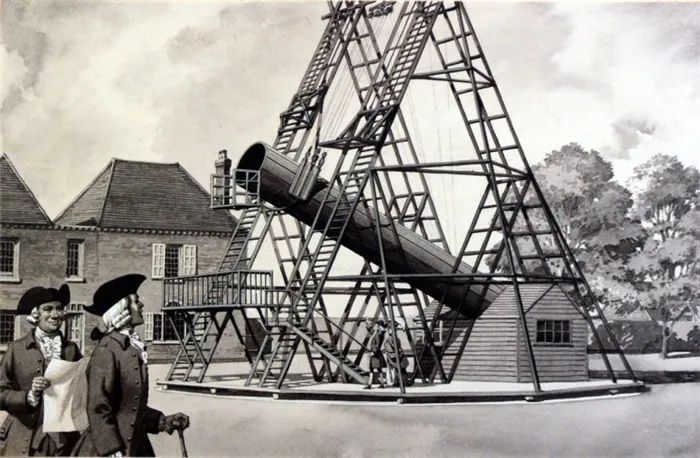
M.V. Lomonosov, a prominent Russian scientist, was not only the inventor of more than a dozen groundbreaking optical instruments, but also the founder of the Russian school of scientific and applied optics. Among his many innovations, Lomonosov developed a groundbreaking telescope that revolutionized night vision, aptly called the “night telescope”. Additionally, he also created a new type of telescope reflector, which was later utilized by Herschel in his renowned telescope experiments.
Herschel’s optical instruments for observing celestial bodies
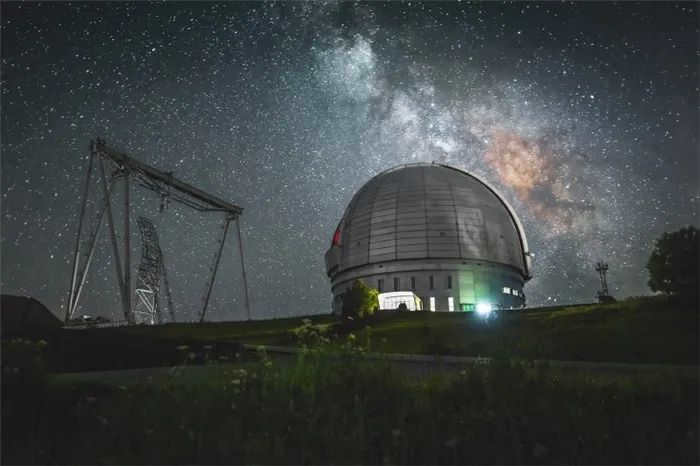
John Frederick William Herschel was the first person to invent his own telescope in 1774, using the ideas and calculations of Lomonosov (although some sources suggest that Herschel and Lomonosov independently came up with optical systems with the same principles of operation). Herschel made several improvements to the telescope’s design, eventually constructing a 20-foot long telescope. This instrument was quite large and required a team of four workers to maintain it. For many decades, it held the title of being the largest telescope in the world.
Herschel produced an extensive catalog of stars and nebulae, conducting valuable research on the planets within our solar system. In a significant discovery in 1781, he confirmed that Uranus was indeed a planet, distinguishing it from a star. Additionally, Herschel identified two satellites of Uranus and two satellites of Saturn. His son, also involved in celestial optics, dedicated several years in South Africa designing a comparable telescope to explore the skies of the southern hemisphere.
The telescope stands as the primary instrument for astronomers. The term “telescope” originates from the Greek words “tele” meaning “far” and “skopeo” meaning “looking”. This designation was proposed in 1611 by Greek mathematician Ioannis Dimisianos. Essentially, a telescope is a device that collects electromagnetic radiation, including visible light, enabling the observation of distant objects.
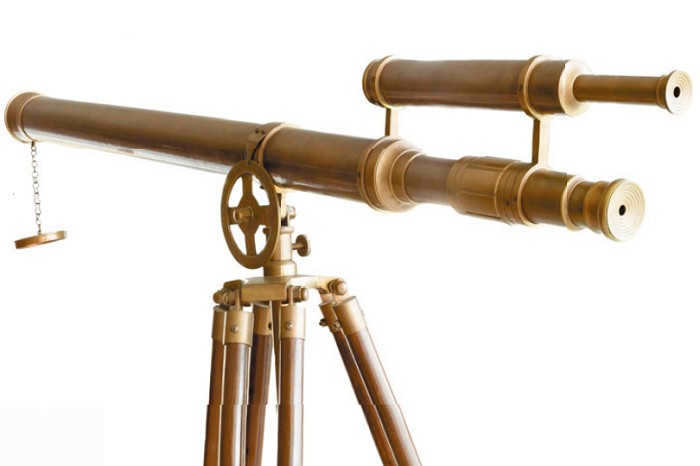
The history of the telescope dates back several centuries. Leonardo da Vinci created the first sketches of a basic telescope using lenses. However, it was not until 1608 that Hans Lippersguy, a Dutchman, demonstrated his own version of a telescope in The Hague. During that time, there were also other craftsmen constructing similar devices.
Nevertheless, it was Galileo Galilei who truly revolutionized the telescope.
He directed it towards the heavens and gathered the initial scientific data. This breakthrough occurred in 1609. Galileo’s initial telescope provided threefold magnification, while his second had eightfold magnification. His third telescope boasted a remarkable 32-fold magnification.
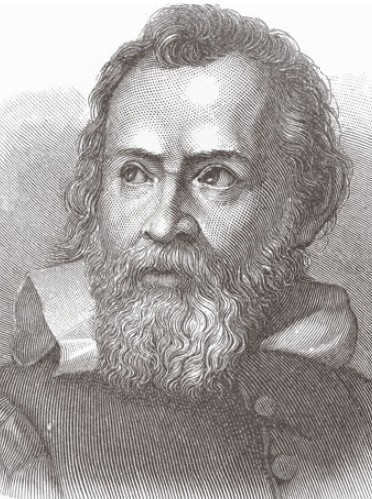
The telescope is structured as a tube that is mounted on a mount and has axes for pointing towards the object being observed. A visual telescope consists of a lens and an eyepiece. The eyepiece can be substituted with a photographic film or any other radiation receiver, transforming the telescope into an astrograph.
Radio telescopes, equipped with a receiving antenna and a radiometer, are used for studying celestial objects in the radio range. In order to enhance the resolving power of telescopes, they are combined into interferometers, and a single network can include telescopes positioned in different regions of the world.
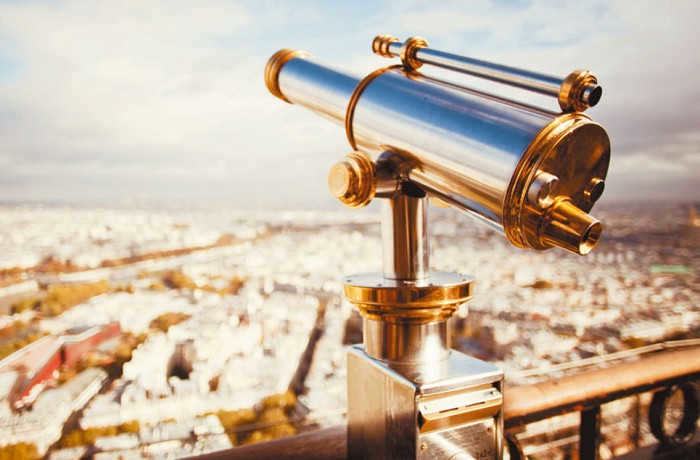
Small telescopes have a wide range of applications, not just for observing stars, but also for capturing breathtaking views of cities, the sea, and other landscapes.
However, there are some limitations when using terrestrial telescopes. The atmosphere is not uniform, and constant winds can distort the image. Additionally, terrestrial telescopes have a lower resolution, typically limited to around 1 arc second. Furthermore, the atmosphere only allows radiation in the optical, infrared, and radio wavelengths to pass through. Unfortunately, the smaller the wavelength, the more difficult it is to perceive, which means that observations in the ultraviolet, X-ray, and gamma-ray bands can only be conducted in space. This is why observatory satellites are currently operating in Earth’s orbit.
Contemporary Telescopes
The instruments of Galileo and Newton, such as modern optical telescopes, spectrographs, solar telescopes, and astrographs, have undergone significant transformations.
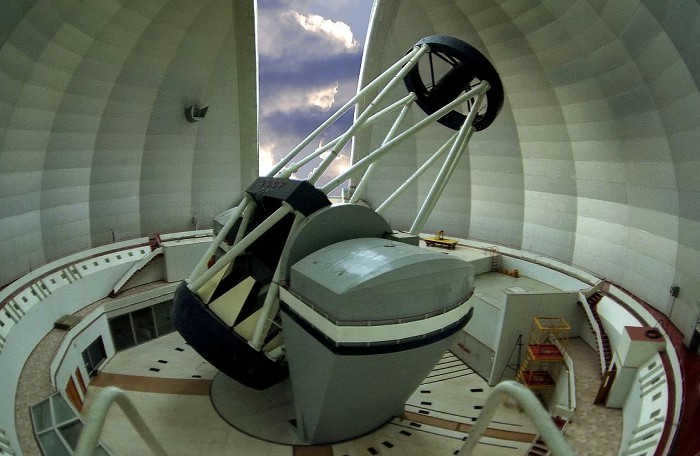
The latest generation of mirror telescopes features primary mirrors measuring 8-10 m in diameter and have the ability to independently correct for atmospheric interference. The 10-meter Keck I and Keck II telescopes (USA), the 9.2-meter Hobby-Eberly telescope, the 8-meter Gemini and Subaru telescopes, the VLT telescope of the European Southern Observatory, and the LBT Large Binocular Telescope currently being constructed in Arizona (USA) are the leaders in terms of resolving power among these colossal instruments.
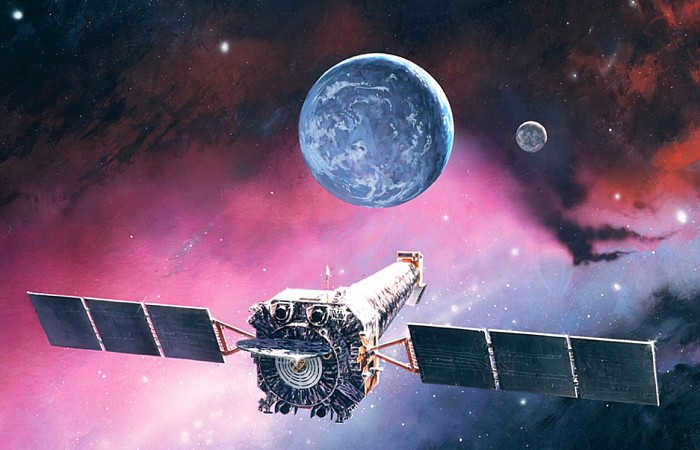
Additional and unique tools of understanding – telescopes using infrared, ultraviolet, X-ray, and gamma-ray radiation – are too intricate and sensitive to function within the confines of Earth. In order to shield them from “interference from Earth” and gather valuable new data about the vastness of the cosmos, these instruments are positioned on board orbiting astronomical observatories.
The Canary Islands’ Impressive Telescope
The race among the world’s largest astronomical observatories to construct increasingly larger instruments and expand the size of their mirrors is ongoing. A state-of-the-art reflector telescope now occupies an entire building and is controlled by multiple computers. The most impressive telescope in Eurasia was constructed in Russia, specifically in the North Caucasus near the village of Zelenchukskaya. This telescope boasts a main mirror with a diameter of 6 meters, weighing approximately 70 tons. The manufacturing process for this mirror spanned over two years. However, the current reigning champion of all Earth-based astronomical instruments is the Great Canary Telescope, which was constructed in the Canary Islands through a collaboration between scientists from Mexico, Spain, and the United States. With a mirror diameter of 10.4 meters, this telescope is capable of discerning objects in interstellar space that are a billion times fainter than what the human eye can perceive.
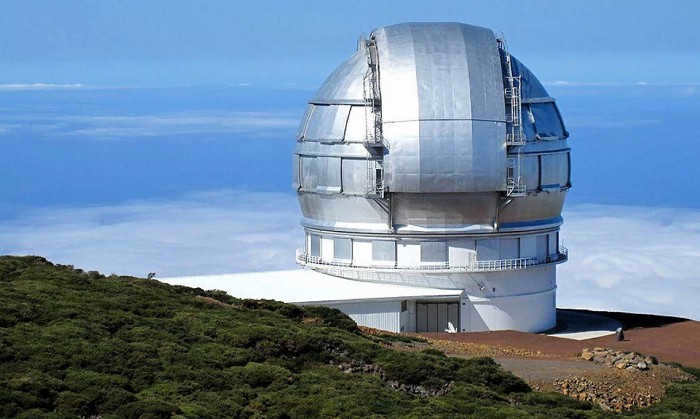
Types of Telescopes
Various types of telescopes have been developed to observe different ranges of the electromagnetic spectrum. These include:
- Optical telescopes
- Radio telescopes
- X-ray telescopes
- Gamma-ray telescopes
- Neutrino telescopes, also known as neutrino detectors
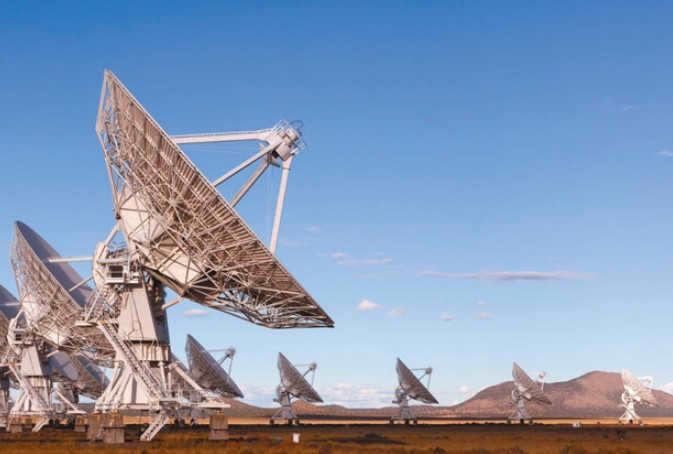
Telescopes can be classified based on their optical system:
- Lenticular telescopes (also known as refractors or dioptric telescopes) use lenses or a system of lenses to focus light.
- Mirror telescopes (also known as reflectors or cataptric telescopes) use concave mirrors to collect and focus light.
- Mirror-lens telescopes (also known as catadioptric telescopes) use a spherical main mirror and additional lenses to correct for aberrations and improve image quality.
- Special solar telescopes are designed specifically for observing the Sun.


